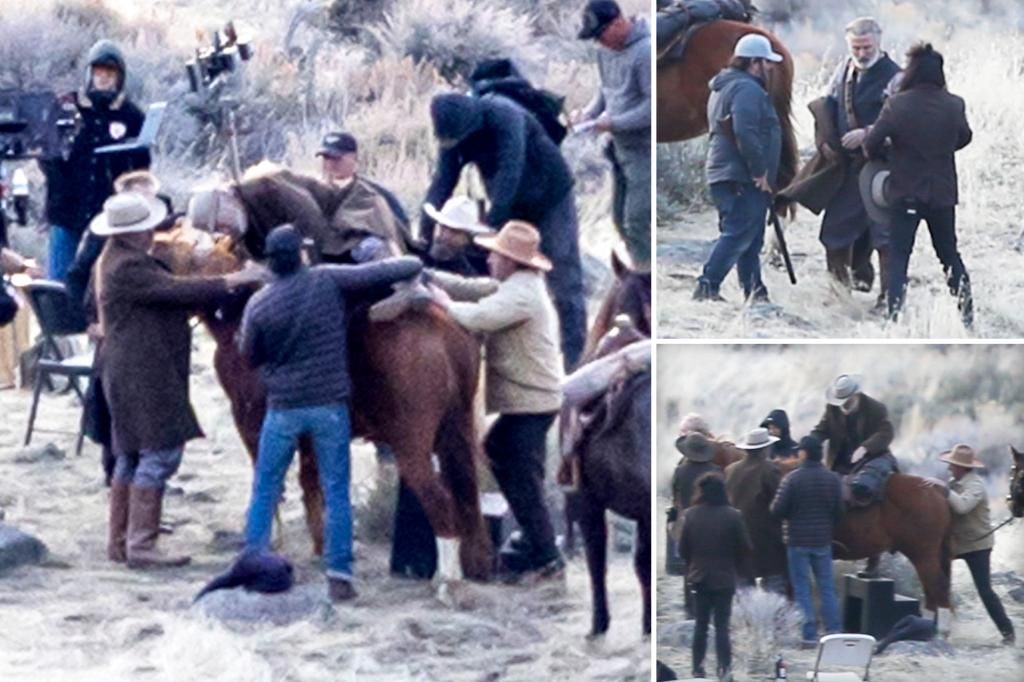Wes Anderson’s ‘Asteroid City’ Has Sharply Divided Cannes
Imagine you’re a filmmaker, and you’ve assembled a dream cast of A-list stars, crack character actors, and your usual stock company of famous faces. Your production-design team has gifted you with a set that’s evocative of a 1950s Southwestern desert landscape, complete with Monument Valley vistas and Route 66 iconography. The costume designer has absolutely nailed the period couture, from cowpoke denim-on-denim to aristocratic golf duds to bewitching fitted dresses. The sunbaked color palette suggests a faded postcard from family vacations past. A longtime friend and fellow idiosyncratic writer-director has helped you co-concoct a conceptual plot, one involving a Playhouse 90-style TV show presenting a three-act stage show, involving various folks thrown together by circumstance. It’s a perfect fit for your own brand of meticulous, go-symmetrical-or-go-home visual sense. Also there is a UFO.
And then, with everything ready to operate in stylistic sync, you ask yourself: OK, so how will I use all of these elements to express something? What do I have to say — about the nation at a historical turning point, about the staring contest between strict conformity and a burgeoning counterculture, about the anxieties of the Atomic Age bumping up against a brave new consumerist frontier? You wait for the answer. And wait. And wait.…
An all-star road trip to Nowheresville USA, Wes Anderson’s Asteroid City is unmistakably the work of one of the few modern directors who can genuinely be called an auteur: You know his camera movements, his characters, his compositions crammed with aesthetic bric-a-brac the second you see them. It’s also a jumble of ideas colliding into one another like particles in an accelerator, with none of them ever taking hold or turning into something resembling a cohesive narrative. There’s enough gorgeous Andersonaphernalia to get lost in onscreen that you might not mind the loose, ambling feel of his ensemble comedy, and be content to just bask in the wild, wild Wes of it all. Eventually, though, you’ll find yourself getting as restless as the trapped tourists and reluctant visitors stuck in the titular burg, scouring the horizon for a destination — any destination — and finding zilch. Editor’s picks
Actually, let’s correct ourselves: This is less a comedy and more of a “comedy,” in scare quotes. As with a lot of Anderson’s past work, there’s a dry comic rhythm to the proceedings that’s tinged with melancholy, though the existential funk that hovers over Asteroid City is a heavier-than-usual fog. This tiny way station of old-fashioned Americana consists of a single-pump gas station, a 10-room motel (technically nine rooms and a tent; one cabana recently burned down), a dozen-seated diner, and a local population of 87. A two-lane highway runs through it. The main attraction is a crater where, millions of years ago, a meteorite touched down. It’s about to host a Junior Stargazers conference, where the country’s best and brightest underage scientists, dubbed the “Brainiacs,” will get a chance to win a prize.
Asteroid City is a little less than a blip on a AAA road map, in other words. It’s also not real, in both the outside-the-frame sense and within-the-movie sense. It’s the location of a play written by noted Southern playwright and bon vivant Conrad Earp, played by Edward Norton as an amalgamation of Edward Albee, Tennessee Williams, William Inge, and Colonel Sanders.
(Let us pause and pay tribute to the fact that, if nothing else, Anderson’s name game continues to be 100 percent on-point: In addition to Earp, the primo monikers include Schubert Green, Saltzburg Keitel, Stanley Zak, Augie and Woodrow Steenbeck, and a five-star Army general blessed with the alliterative handle Grif Gibson. Let a thousand chef’s kisses be unleashed!)
A TV-show host (Bryan Cranston, rockin’ the Rod Serling vibes) is presenting this previously unproduced work for an evening’s black-and-white entertainment, taking us behind the scenes as the crew sets up and the New York actors playing each part prep to get onstage. For every archetype we see in this immersive fake desert town, there’s a monochromatic Gotham thespian counterpoint, treading the boards and tearing their hair out over character motivation. The skipping between both sides of the looking glass will soon become porous. But first, meet the three-act (and an epilogue) protagonists: Related
[Cue whimsical narration from well-known voice actor, accompanied by the Les Paul and Mary Ford deep cut of your choice.]
—Augie Steenberg (Jason Schwartzman), a war photographer who’s using this trip to A.C. — his son, Woodrow (Jake Ryan), has entered his science project in the Stargazers competition — informs his children that their mother has just passed. His father-in-law, Stanley (Tom Hanks, acting as if someone filled his shoes with thumbtacks), eventually jumps in his Cadillac and drives into the desert to join them as well.
—Midge Campbell (Scarlett Johansson, playing 1950s glamorpuss so well that you wish she hadn’t missed the Golden Age of Hollywood by decades), a movie star who’s here with her daughter, Dinah (Grace Edwards). Augie takes her picture while she’s eating waffles. They will fall in love. Or at least she lets him see her in the nude. Six of one.
—Several other parents of the Brainiacs, all of them neurotic about their genius prodigies, and several of whom sip martinis dispensed from kooky vending machines. (Other items you can purchase from these miracles of instant gratification: soda pop, candy bars, real-estate deeds.) They’re played by Liev Schreiber, Hope Davis, and Steve Park. The head Brainiac leading this next generation to scientific glory? That’s Dr. Hickenlooper (Tilda Swinton).
Jason Schwartzman and Tom Hanks in Asteroid City Pop. 87 Productions/Focus Features
Then there’s Jeffrey Wright’s gung-ho military man, Matt Dillon’s bubbleheaded grease monkey, Steve Carell’s apologetic motel owner, Maya Hawke’s friendly schoolmarm, and Rupert Friend’s cowboy loverboy. Blink, and you may miss Willem Dafoe, Margot Robbie, Jeff Goldblum, Adrien Brody, Bob Balaban, and Jarvis Cocker (crooning as part of a range-riding Texas swing outfit). They show up to add to the goofiness and the sense of mournfulness that trade places with equal measure. When a stop-motion alien shows up and steals the meteorite, the town is forced to quarantine and go a little cuckoo. A minor carnival-like atmosphere ensues, complete with Ferris wheel and souvenirs, before fading away. Trending Tina Turner, Queen of Rock & Roll, Dead at 83 Why Did the Idaho Murders Suspect Stay Silent Instead of Entering a Plea? ‘The Idol’ Is More Toxic and Way Worse Than You’ve Heard Trump’s Secret Weapon to ‘Ratf-ck’ DeSantis
And still, we go back and forth between New York and Asteroid City, the Method actors and the motorists stranded in Nowheresville, in the name of … something? There are digs at the notion of performance and the insular world of creative incubators like the Actors’ Studio, the early days of mass media and the Eisenhower-era eccentrics who lived on the fringe, the military-industrial complex, Watch the Skies! sci-fi pulp, the mythology of the open highway, and the tyranny of closed minds. Grief connects many of these wandering souls who’ve converged upon this first-contact area. What the movie might say about all of this, however, rests underneath layers of whimsy, impeccably framed portraits of midcentury kitsch, and the occasional country & western ditty taken deep from what we assume is Anderson’s 78-rpm album collection, played on an antique phonograph.
It’s all very pleasurable to take in, even as you pull your hair out by the roots in search of a point beyond the pretty pictures. Anderson is too talented, too singular a filmmaker to make inside-baseball outsider art for its own sake; he’s been doing this too long to simply rely on a style that’s now calcified into shtick as well. Asteroid City has already divided the press corps at Cannes, causing staunch haters to recant their previous statements, and inspired longtime Wes stans to tear up their carefully designed Sons of Anderson membership cards. For me, this isn’t a deal breaker — he’s made far worse and much, much better. But to see this sui generis Amerindie star fall to earth with a resounding thud, leaving just a stunningly designed and studiously empty hole in its wake, is a cosmic bummer.
Source: Rolling Stone


